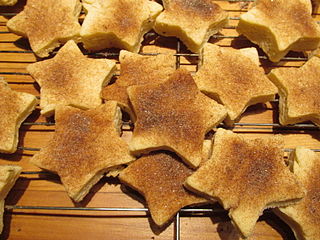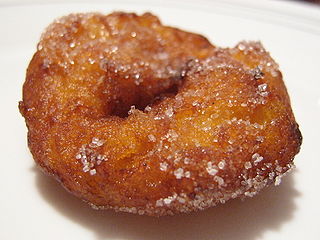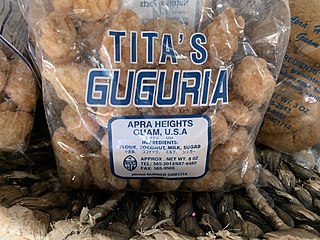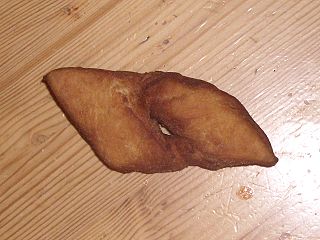
A snickerdoodle is a type of cookie made with flour, fat, sugar, and salt, and rolled in cinnamon sugar. Eggs may also sometimes be used as an ingredient, with cream of tartar and baking soda added to leaven the dough. Snickerdoodles are characterized by a cracked surface and can be either crisp or soft depending on the ingredients used.

A sugar cookie, or sugar biscuit, is a cookie with the main ingredients being sugar, flour, butter, eggs, vanilla, and either baking powder or baking soda. Sugar cookies may be formed by hand, dropped, or rolled and cut into shapes. They may be decorated with additional sugar, icing, sprinkles, or a combination of these. Decorative shapes and figures can be cut into the rolled-out dough using a cookie cutter.

The bizcochito or biscochito is a New Mexican cuisine crisp butter cookie, flavored with sugar, cinnamon, and anise. The dough is rolled thin and cut into the shape of the fleur-de-lis, the Christian cross, a star, or a circle, symbolizing the moon.

Christmas cookies or Christmas biscuits are traditionally sugar cookies or biscuits cut into various shapes related to Christmas.

Czech cuisine has both influenced and been influenced by the cuisines of surrounding countries and nations. Many of the cakes and pastries that are popular in Central Europe originated within the Czech lands. Contemporary Czech cuisine is more meat-based than in previous periods; the current abundance of farmable meat has enriched its presence in regional cuisine. Traditionally, meat has been reserved for once-weekly consumption, typically on weekends.

A buñuelo (Spanish:[buˈɲwelo]; alternatively called boñuelo, bimuelo, birmuelo, bermuelo, bumuelo, burmuelo, or bonuelo is a fried dough fritter found in Spain, Latin America, and other regions with a historical connection to Spaniards, including Southwest Europe, the Balkans, Anatolia, and other parts of Asia and North Africa. Buñuelos are traditionally prepared at Christmas. It will usually have a filling or a topping. In Mexican cuisine, it is often served with a syrup made with piloncillo.

Springerle is a type of South German biscuit or cookie with an embossed design made by pressing a mold onto rolled dough and allowing the impression to dry before baking. This preserves the detail of the surface pattern. While historical molds show that springerle were baked for religious holidays and secular occasions throughout the year, they are now most commonly associated with the Christmas season.

Pfeffernüsse are small spice cookies, popular as a holiday treat with Germans and ethnic Mennonites in North America. Similar cookies are made in Denmark, and The Netherlands, as well. They are called Pfeffernüsse in German, pepernoten in Dutch, päpanät in Plautdietsch, pfeffernusse or peppernuts in English, and pebernødder in Danish.

Cardamom breads, including the Finnish pulla and Swedish kardemummabröd and kardemummabullar, are a group of enriched breads or pastry flavored with cardamom. They are eaten throughout the year, typically with coffee or tea.

Jumbles are simple butter cookies made with a basic recipe of flour, sugar, eggs, and butter. They can be flavored with vanilla, anise, or caraway seed used for flavoring, or other flavoring can be used like almond. They were formerly often made in the form of rings or rolls.

Kürtőskalács is a spit cake specific to Hungarians from Transylvania (Romania), more specifically the Székelys. Originally popular in the Hungarian-speaking regions of Romania, more predominantly the Székely Land, it became popular in both Hungary and Romania. The first written record dates back to 1679 and was found in the village of Úzdiszentpéter, while the first recipe appears in a manuscript cookbook dated in 1781. Earlier a festive treat, now it is part of everyday consumption. In Transylvania, a similar pastry to Kürtőskalács is Baumstriezel, originating in the Saxon communities.

The poppy seed roll is a pastry consisting of a roll of sweet yeast bread with a dense, rich, bittersweet filling of poppy seed. An alternative filling is a paste of minced walnuts, or minced chestnuts.

Guyuria are traditional Chamorro cookies. They are also known as Chamorro jawbreaker cookies due to their historically rock-hard texture. Guyuria was originally made with flour, coconut milk, and a sugar glaze. The dough is first made as one solid mass. Small pieces of dough are pinched off. Each piece is rolled out on a wooden guyuria board or on the back of a fork. Once enough cookies are formed, a batch is fried, cooled, and finally coated with a sugar glaze. The glaze is then allowed to dry on the cookies.

Klenät, kleinur, klena, klejne, kleina, kleyna, and fattigmann are all names for angel wings, a fried pastry common in the Nordic countries as well as the rest of Europe and the United States. In nearby countries and Eastern European countries. The name is related to klen, the Swedish term for "slender", but is originally of Low German origin, which may indicate that the pastry was originally German. It is made from flattened dough cut into small trapezoids. A slit is cut in the middle and then one or both ends pulled through the slit to form a "knot". The kleina is then deep-fried in oil or another kind of fat. Subsequently can be sprinkled with powdered sugar and cinnamon.

Magenbrot is a small, sweet glazed biscuit that shares many similarities with a gingerbread cookie. The name of the dish directly translates to "stomach-bread" as it is believed to help improve digestion. This recipe first appeared in Swiss cooking books in the late 18 century. It is usually sold in Christmas markets in northern Switzerland and southern Germany. It is known by many names including Honigkuchen, Gewürzkuchen, or Kräuterbrot.
Biscochos, also known as biscochos de huevo, or biscotios, are a traditional Sephardi Jewish ring-shaped cookie commonly prepared for Hanukkah, Purim, and other Jewish holidays.
Pie in American cuisine has roots in English cuisine and has evolved over centuries to adapt to American cultural tastes and ingredients. The creation of flaky pie crust shortened with lard is credited to American innovation.
















